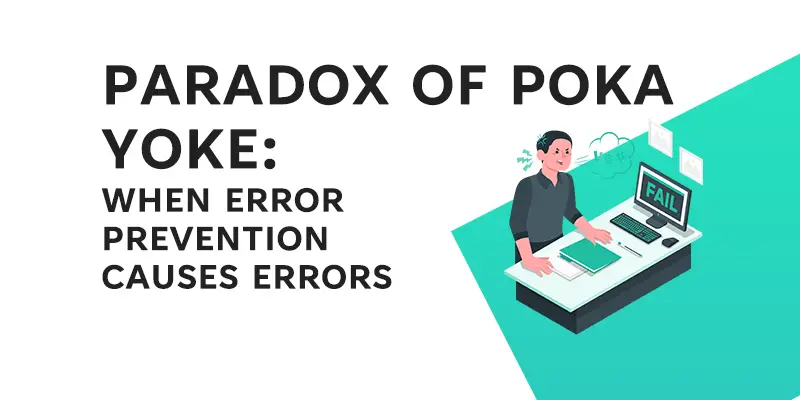You’ve probably heard the phrase “prevention is better than cure,” right? In the world of quality control and continuous improvement, this idea takes the form of a Japanese technique called “Poka Yoke.” Simply put, Poka Yoke is a safeguard that helps prevent mistakes before they happen.
Imagine a USB plug that only fits one way, so you can’t insert it incorrectly—that’s Poka Yoke in action. But what if I told you that sometimes, the very system designed to stop errors could actually cause them? Sounds like a paradox, doesn’t it? In this article, we’re going to dive into this intriguing conundrum. We’ll explore situations where Poka Yoke might not be the perfect solution and could even backfire, leading to more complications. So, if you’ve ever wondered whether Poka Yoke is always the right choice, read on to find out more!
Table of Contents
The Theory Behind Poka Yoke
Before we delve into the complexities, let’s get a better grasp of what Poka Yoke is all about. Originating from Japan, the term translates to “mistake-proofing.” In essence, Poka Yoke is a simple, clever mechanism designed to prevent errors from occurring. Think of it as a guardian angel that gently guides you away from making blunders.
For instance, many microwaves have a feature that prevents them from starting until the door is securely closed. This simple measure protects you from the risk of harmful radiation exposure. Similarly, some cars won’t let you start driving unless you’ve buckled your seatbelt. It’s like having a co-pilot that cares about your safety and nudges you to do the right thing.

The beauty of Poka Yoke lies in its simplicity. It’s often a straightforward solution that eliminates the chance of error at the source. Moreover, Poka Yoke systems are generally affordable and easy to implement, making them a go-to method for enhancing quality and safety in various industries.
In a nutshell, Poka Yoke is like your friend who always reminds you to turn off the oven before leaving the house—an unobtrusive yet effective way to avoid mishaps.
Now that we’re all on the same page about what Poka Yoke is and how it generally helps us, let’s take a look at the other side of the coin. What happens when this helpful friend becomes a hindrance?
When Poka Yoke Becomes a Paradox
We’ve seen how Poka Yoke acts like a helpful friend, always looking out for us. But even the best of friends can sometimes overstep their boundaries, right? Similarly, there are situations where Poka Yoke might be more of a hindrance than a help.
Overcomplication of Processes
Imagine you’re baking a cake and your mixer has ten different safety checks before it starts. It sounds safe, but it’s also tedious and frustrating. If a Poka Yoke system makes a task too complicated, people might start looking for shortcuts, which defeats the purpose and can introduce new errors.
User Resistance or Misuse
If a safety feature is too intrusive, people might try to bypass it. Think about those car alarms that are so sensitive they go off when a leaf falls on the car. Over time, people may start ignoring the alarms, which reduces their effectiveness.
Resource-Intensive Implementations
Poka Yoke is usually praised for being cost-effective, but that’s not always the case. In some situations, the time, effort, and money spent on installing and maintaining a Poka Yoke system could be better invested elsewhere.
The paradox here is clear: a mechanism meant to reduce errors might end up causing them due to overcomplication, resistance, or impracticality. It’s like having a friend who’s so protective that they keep you from living your life freely. In such cases, the question arises—Is Poka Yoke really the best solution for the problem at hand?
Real-world Examples Across Industries
To better understand this paradox, let’s take a look at some instances from various sectors where Poka Yoke didn’t exactly hit the mark.
Manufacturing: Over-Engineered Safety Checks
In a factory that produces electronics, an over-engineered Poka Yoke system required workers to go through five different checks before operating a machine. The result? Slower production speeds and frustrated employees who started to bypass some of these checks, leading to occasional quality lapses.
Automotive: Sensitive Brake Systems
Some modern cars have overly sensitive automatic braking systems as a form of Poka Yoke. While the intention is to prevent collisions, these systems can sometimes activate unnecessarily, startling the driver and causing confusion on the road.
Public Sector: Digital Forms that Overcomplicate
In an effort to prevent errors in online applications for public services, some digital forms have been designed with numerous checks and validations. However, the process became so complex that people either abandoned the form halfway or filled it out incorrectly, defeating the purpose of error prevention.
Logistics: Inventory Overchecks
In a warehouse, a Poka Yoke system was set up to triple-check inventory counts. While this seemed like a good idea, it led to significant delays in updating inventory data. The time spent on excessive checks could have been used more productively.
As you can see, the Poka Yoke paradox isn’t limited to one industry. Whether it’s manufacturing or public services, the protective friend can sometimes turn into a meddling companion who ends up causing more harm than good.
Identifying When Poka Yoke is Not Ideal
By now, you might be wondering how to tell if Poka Yoke is right for your situation or if it could turn into a paradox. Here are some factors to consider:
Cost vs. Benefit
Sure, a system that performs a dozen checks sounds foolproof. But what’s the cost of implementing and maintaining such a complex system? Weigh the cost against the potential benefits to determine if it’s worth it.
Complexity
Simplicity is the essence of Poka Yoke. If your proposed solution feels too complex or cumbersome, it’s probably a good idea to revisit the drawing board.
User Training
How easy is it for your team to adapt to the new system? If it requires extensive training, consider whether that investment of time and resources is justified.
Feedback and Metrics
Data doesn’t lie. If you’ve already implemented a Poka Yoke measure, keep an eye on performance metrics. Any increase in errors or delays might indicate that your system is becoming a paradox.
Remember, the goal is to make tasks simpler and more efficient, not create new hurdles. So, take a step back and critically evaluate the appropriateness of Poka Yoke in your context.
Alternatives to Poka Yoke
At this point, you might be pondering, “If Poka Yoke can backfire, what else can I use to prevent errors?” Well, you’re in luck. There are several other approaches to error prevention that may better suit your needs.
Kaizen
If the issue is with continuous, smaller errors rather than big, glaring mistakes, the Kaizen methodology focuses on continuous improvement and might be more appropriate.
Standard Work Instructions
Sometimes, well-documented and straightforward instructions are all that’s needed to guide people through a process without error. These can be especially useful for complex or infrequently performed tasks.
Statistical Process Control
For situations requiring a more analytical approach, statistical methods can monitor performance metrics and flag anomalies in real-time, allowing you to make immediate corrections.
Automation
In cases where human error is highly probable and costly, fully automating the process may be the best solution. However, keep in mind that automation comes with its own set of challenges, like initial costs and ongoing maintenance.
Checklists
Simple, but effective. For tasks that involve multiple steps or components, a checklist can ensure nothing gets overlooked without introducing unnecessary complexity.
In summary, while Poka Yoke is a powerful tool, it’s not the only one in your error-prevention toolkit. Depending on your specific challenges, other methodologies or even a combination of methods could offer a more effective solution.
Conclusion and Key Takeaways
As we wrap up, it’s important to remember that no single tool or methodology is a one-size-fits-all solution. Poka Yoke, with its emphasis on simplicity and error prevention, is an invaluable asset in the realm of quality control and continuous improvement. But as we’ve discussed, even this seemingly foolproof system can have its limitations and may even become counterproductive in certain contexts.
Key Takeaways:
- Simplicity is Core: Poka Yoke is most effective when it simplifies processes rather than complicating them.
- User Acceptance Matters: A system is only as good as its adherence. If users find it cumbersome, they are likely to bypass it, defeating the purpose.
- Cost vs. Benefit: Always weigh the costs of implementation and maintenance against the benefits.
- Metrics are Crucial: Keep an eye on performance indicators to gauge the effectiveness of any system you implement.
- Know Your Alternatives: When Poka Yoke isn’t the right fit, consider other methodologies like Kaizen, Standard Work Instructions, or Statistical Process Control.
The ultimate goal is to streamline processes, reduce errors, and improve quality. Whether you choose Poka Yoke or another methodology depends on your specific needs, the nature of your work, and the context in which you operate.
Remember, the journey towards continuous improvement is just that—a journey. Being flexible and adaptive in your approach will help you navigate the path more effectively.
References
- Dudek-Burlikowska, M. and Szewieczek, D., 2009. The Poka-Yoke method as an improving quality tool of operations in the process. Journal of Achievements in Materials and Manufacturing Engineering, 36(1), pp.95-102.
- Saurin, T.A., Ribeiro, J.L.D. and Vidor, G., 2012. A framework for assessing poka-yoke devices. Journal of manufacturing systems, 31(3), pp.358-366.








